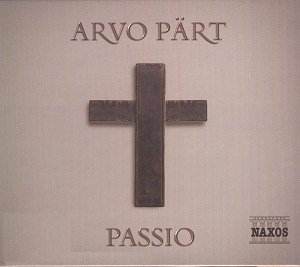Arvo Pärt has become somewhat of an icon
amongst lovers of choral music, alongside his British contemporary
John Tavener. Born in Estonia in 1935, the composer suffered like
many of his colleagues at the restrictive hands of the Soviet
party bosses who attempted, thankfully unsuccessfully, to control
the artistic output of their composers. Although Pärtís early
work reflects the influence of Schoenberg and the atonal and avant-garde
movements of the mid-century, his more recent music reflects his
enlivened interest in the medieval masters. His now very widely
performed output reflects an austerity that is almost monastic,
and a simplicity that would have made even St. Francis of Assisi
proud. His work is created from a rigorous set of self-imposed
rules derived from a technique known as tintinnabuli, or
the mathematically exact connection of one voice to another. For
Pärt, all voices are one, and their relationship to one another
is seen as an expansion of the one voice, rather than several
voices working against each other. Based predominantly on the
simple triad, Pärtís music seems simplistic on the surface,
but as one delves into the careful and immaculate way in which
he sets a text, one is opened up to a brand new and exciting tonal
world.
The Passio from 1982 uses the ancient
practice of chanting the biblical narrative that dates back to
as early as the fourth century. No Bach passion this, with florid
and emotionally riven arias and stormy crowd scenes. Rather, we
have an austere telling of the story, the emphasis on the intelligible
declamation of the text.
Tonus Peregrinus is a fine ensemble, exhibiting
spotless intonation, and a clear sense of the rhythmic ebb and
flow of the text. Anthony Pitts favors brisk tempi in this rendition,
with his performance coming in nearly fifteen minutes faster than
Paul Hillierís first recording of the work, and the composerís
suggested duration of seventy-five minutes. The evangelist quartet
singing is excellent, with careful attention to detail, and spot-on
choices in dynamics, articulation and phrasing. The composer makes
very few suggestions in the score in relation to these issues;
rather he leaves the performers to interpret the music in direct
relation to the drama of the text.
Robert McDonald takes what I feel is the perfect
tone in his singing of Jesus. Each time he sings, you feel the
profundity of his words, and he does a magnificent job at making
Jesus seem otherworldly and detached from the folly of his mortal
tormenters. His resonant bass shimmers when he sings, and the
clarity by which I mean a blessed lack of typical bass Ďwoofinessí
of his timbre is breathtaking.
If there is any lapse in judgment in this performance,
it is the reedy, throaty singing of tenor Mark Anderson, whose
somewhat grating voice makes Pilate more of an annoyance than
a character of intelligence and refinement. Anderson does little
to project Pilateís honest fear at what he is forced to do to
Jesus. Rather, he comes across as somewhat flippant and disengaged.
I found his singing to be a distraction to an otherwise outstanding
and well-paced performance. Conductor Anthony Pitts is most careful
to allow the reverberant acoustic of his church to complement
the sonorous nature of this music.
Sound quality is excellent. Naxosís engineers
capture the warm and lengthy reverberation of the church of St.
Peter and St. Paul beautifully. There are now three commercial
recordings of this fine work in circulation, and this one is certainly
world class. Naxos have gone out of their way to present this
recording in fine packaging with a simple yet profound sleeve
cover, and the notes by the conductor are superb. Full text and
translations are provided, another plus not common to Naxos, but
utterly necessary for any choral or vocal recording to be taken
seriously.
Now twenty-one years old, this is a work that
is coming into its own and holding onto its place as an important
composition. Long may it live, and this recording has certainly
contributed to its future appreciation.
Kevin Sutton
See also review
by Neil Horner

